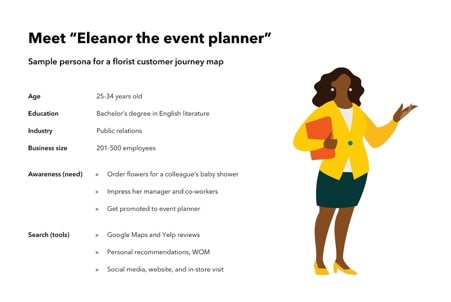Phase 3: Consider
Once a customer has discovered your product or service, it’s time to stand out from the rest.
This is the first moment of truth for a customer. In P&G’s words, it’s their “a-ha moment when confronted with the product and alternatives in real life.”
Here’s how Eleanor might approach the consideration phase:
- She visits each company’s site, Pinterest, or Instagram page
- She checks out online reviews looking for the highest number of stars
Eleanor chooses a local florist whose Yelp and Google reviews are top-notch and has e-commerce capabilities in case she wants to order online later. For her first purchase, however, she wants to speak in-person with a salesperson anyhow to ensure they understand precisely what she needs.
On a lunch break, she visits the storefront. It smells lovely, and the fresh and beautiful flower displays make her feel like the store owners are very creative.
The shopkeeper is friendly, knowledgeable about creating bouquets for events, and makes her feel welcome. The shopkeeper recommends a few beautiful arrangements based on her budget
She also mentions she’ll give Eleanor a 20% off coupon for her next purchase.
Eleanor loves the shopkeeper’s professionalism and bouquet suggestion. She feels good about buying. She also wants that 20% off deal.
Let’s break those last few paragraphs down into lessons you can apply
The decor or design.
What story do you want your product displays and overall ambiance to tell your customers? Also, how can you help them find what they need quickly and easily? You want to leave a lasting first impression.
If you sell online, the same rules apply—only you have to be even more creative in how you tell your brand story and merchandise your products. You can’t rely on all five of your customers’ senses to drive an emotional response. That’s where following best-practices from other small business websites come into play.
Free WiFi in-store.
According to RetailDive , 71% of shoppers use their phones to research products in a store. The easier it is for customers to research their options in-store and use their phones while they wait, the more likely it is for them to spend more time and money there.
Special offers.
Even if you don’t have a physical sales presence, you can still offer free or special discounts to first-time customers to sweeten the deal. For example, many online retailers offer customers a 10% off coupon code for email sign-up.
Knowledgeable and helpful salespeople.
Nothing is more of a turnoff than a salesperson who ignores you or provides little value during a customer’s interaction with your brand—at any point in the sales cycle. Consider incentives to get your staff to provide exceptional customer service.
The purchase or transactional experience of a buyer’s journey is their second moment of truth. This is where they interact with your business as well as your competitors.
Back to our persona’s journey …
- Eleanor returns the next day to buy bouquets
- The shopkeeper offers her a free cup of coffee and biscuits to enjoy while she waits for her order
- The bouquets are beautiful: they look exactly like what Eleanor had imagined
- They also each come with a free vase that matches the decor of the baby shower—the shopkeeper threw them in for free without telling Eleanor as a surprise
- Eleanor gets her 20% off coupon which is printed directly on her receipt
- She is also delighted with the quick and easy transaction when she pays using her company credit card on a POS terminal
- Eleanor walks away feeling extremely satisfied with the florist and her overall shopping experience
- Everyone in the office, her boss especially, gushes about the flowers, decor, and her hard work on the event
- Eleanor feels like a winner and is very grateful to her new favourite florist
So far, the florist has done everything right—from a welcoming environment, having insights about events, putting the customer at ease, offering a deal that’s easy to redeem, and making the transaction quick and painless.
Naturally, buying something online can be more of a hassle. But not if you avoid the most common e-commerce mistakes and ensure mobile payments, in particular, are smooth and easy.
Long checkout forms or multiple checkout screens can frustrate customers. The same goes for unexpected shipping charges. If you sell your products or services online, read up on how to reduce shopping cart abandonment by optimising your checkout.




















